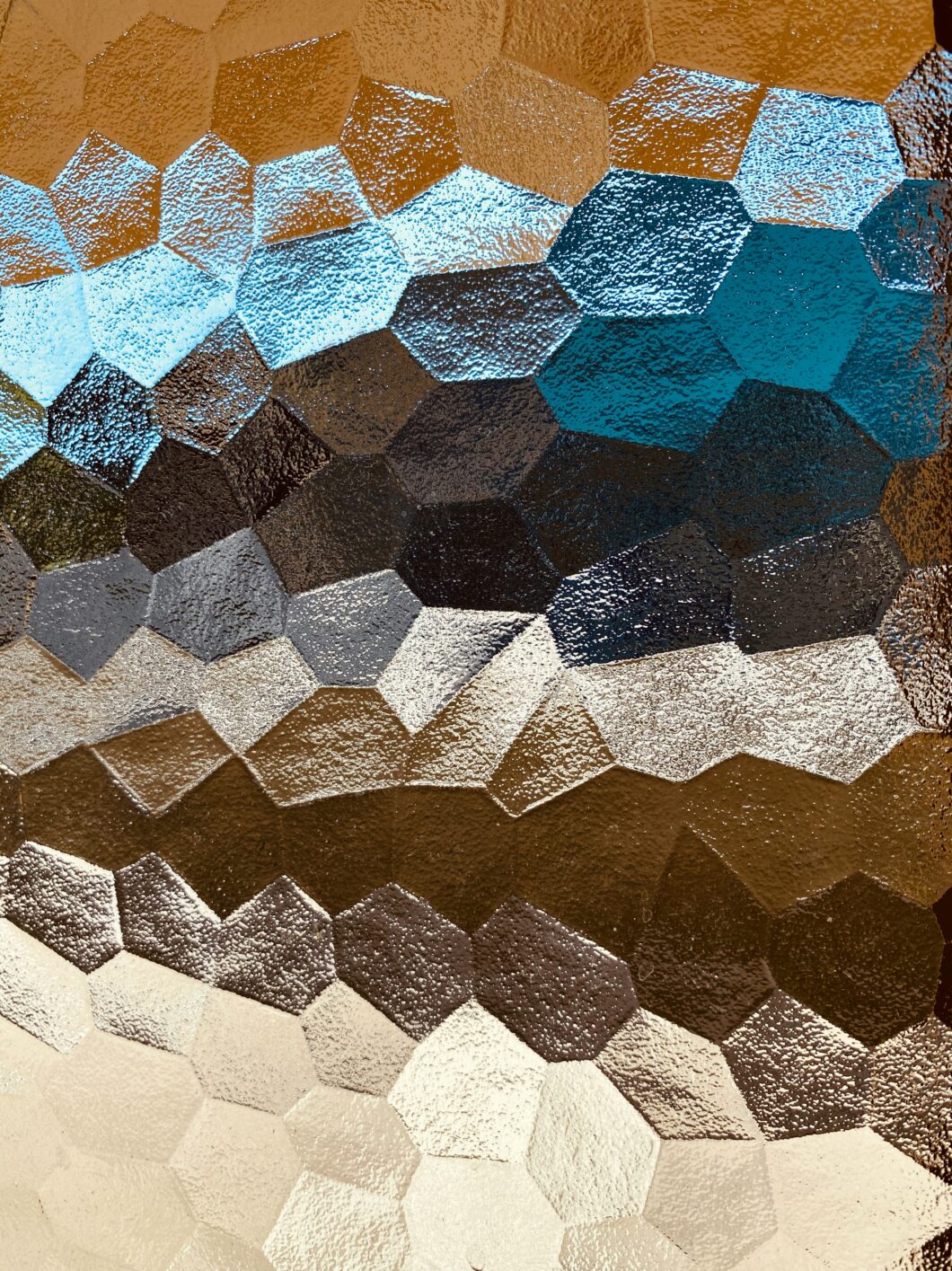1
Childless and widowed, I slide into bed like a bug that scuttles away to escape getting stomped. I am not a bug but I am flattened. By loneliness, worry, missing my boy, now grown. By the encroaching fog of my father’s dementia.
Years ago, his mother made the quilt that covers me. Age and love have beaten it soft. It covered my bed in college. Later, I wrapped it around my newborn son. It warmed my husband in his last good days, on the sunporch where he napped with our cat at his side.
2
The quilt is a bouquet of May colors. Large squares of scarlet and blue with smaller patterned squares in yellows, greens, and pinks. The stitches dimple the fabric like seeds or pores, tiny and even. Stitches tell of a quilter’s fingers—needle, place, and time. A circle of Acadian church women gabbing around a quilting frame, evenings, for months? A solitary woman settled near a sunny window, alone and lonely, or alone and content?
I was widowed once, but my grandmother lost two husbands.
Her piecework emerged from a bag: scraps from worn out work shirts, aprons, and dresses. Worn, torn, dirtied, salted with sweat and bloodied with fish guts or stained with grease. Mended, laundered, flicked with starch, steamed under iron, buttoned, and hung or smoothed and folded, and eventually dropped in a basket. Wear, wash, repeat until they ended up as scraps on the road to redemption. Born again as blankets.
A quilt is quotidian. A record of daily life. Something of my nan, my grampy, and my father is bound up in each seam. A quilter’s thoughts trail the needle into cloth like a boat’s anchor line pierces water.
A quilt is an almanac. The fabrics date it—not only when it was sewn, but when the cloth was made. You can tell from the dyes. The fabric in mine is a hundred years old. Here is Grampy’s best shirt. Nan’s Sunday apron. Auntie’s Easter frock—see it in the old photograph?
I go on a hunt for my father.
3
Does a quilt breathe?
I imagine it does. That it is alive. Talking to me.
4
The handle of Dad’s hunting knife is carved with a six-point buck. The kind of deer he often talked about taking down. He never killed one; he loves them too much. Tracking deer drew him deep into the woods, to the trees and the birds that nested in them.
The knife handle is antler, aged to a color like tea, soiled in the cracks, and blackened by a screw. The blade is rusted red. As a kid, I asked if it was blood. I wanted it to be. I imagined the metal edge cleanly opening hide, the hot liquid spurting out. A side of venison hung from a tree and dressed. A pit fire nearby to stave off cold.
The knife was buried in a drawer in my father’s workshop under screwdrivers, a hammer, a T-square, and rasps. He showed me the knife, then put it back, but I wanted it, so later I stole it. In my bedroom I sat, blade in hand, on Nannie’s quilt, and pondered its secret life. Which was my father’s secret life. Which is to say that holding the knife was as near as I got to touching a man I didn’t know. Thrilled by his secret power. Delilah cutting Samson’s hair.
My thrill turned quickly to grief. I knew: hiding is a kind of burial.
I returned the knife to the drawer.
Years later, my father gave the knife to my son who used it to kill garden slugs. Now it sits on a shelf, clean but not too clean. I want the stain, the grit in the cracks.
I want that love.
5
The year I turned sixteen, my father unearthed a small, gray inkwell on a construction site near the Boston Statehouse. Even my untrained eye recognized a relic: salt-glazed earthenware, its bottom striped with ribs from the colonial potter who drew a wire through the base to lift it from the wheel. Three fingerprints etched in the clay, a message from the potter himself.
By my hand, from earth to object.
The year I turned eighteen, I happened upon a bed of natural clay near a streambed. I filled my pockets with the oily muck and carried it home. There I pinched a pot and buried it in the rosy embers of the wood burning stove. In the morning, I dug out the pot, mica-flecked, charred, and reasonably hard. I kept it and the little clay figures I had fired. But I no longer have them. In college I would test the clay’s ability to withstand a high-heat kiln and find a puddle of red glass where I had set it down.
I had made objects from earth, though—for want of permanence—I had ruined them.
Decades later I found an antique Acadian bean pot in a shop in Pubnico, Nova Scotia. Glazed molasses-brown and patterned all over with stippling, perhaps from the point of a potter’s tool. Or an ivory handled knife. Stripes on the bottom from the potter’s wire and prints from her fingers. A chip from the carelessness of someone long dead. A child, perhaps. I wanted it to be.
Here, here! beamed the bean pot. I’ve been waiting for you.
6
Wooden dories are an assemblage of odd-shaped parts that form an object of utility and grace. Each dory is one of a kind, the product of its builder and pieces of wood that lend themselves to elbows, battens, and oars. My forebears hauled fish in dories, but for me, they are transport to serenity.
A dory speaks poetry to water, a friend said, and I treasure this line like a child’s pocket find. Like a robin’s egg, a marble, an acorn whistle. Secret pleasures.
Old lobster traps were similarly assembled from steamed wood and fastened with strips of hide. They lay bleaching under the maritime sun like bouquets of bones.
7
I was sixteen. One autumn day, I stacked the oak my father was splitting to burn in winter. When he turned his back I took up the awl, balanced it on a heart of oak, and tapped once to set it in. Then I swung the sledgehammer with all my might. There came a dry fibrous cracking and a groan. A thump-thump-thump as the halves rocked back and forth then stopped.
My father turned at the sound. Then he stooped to finger the wood.
“That’s a good clean cut” was all he said before turning away. I knew what that meant: I could split and he would stack.
I rolled up my sleeves and there was my freckle, the old one the shape and color of a raisin. On an arm slim but strong. And graceful.
8
I have neither lobster trap nor dory to memorialize my love of wood. Instead I have beach stones, round and flat. My father said his nan used to heat them in the wood stove then wrap them in quilts. They kept his feet warm in the unheated Whippet, his father’s Sunday car.
Each time I return from Nova Scotia, I bring back one such stone. They are gray and brown and smoothed to velvet by the surf. No matter how many stones I have, I want more. A bit of the homeland more enduring than wood.
A scrap bag, of a kind.
9
Early quilts were stitched as padding for suits of armor. The heavy metal burned, cut, and rusted. Aketon and gambeson, I learn, are words for the wool-stuffed garments worn under or over the armor, respectively, to minimize the blows. The gambeson and jupon, a shorter quilted garment, also bore the coat of arms. The family name and colors.
The middle layer of my quilt is cotton, not wool. Still, it has weight and heft. It is too beautiful to use, I have been told, and some of the squares are so worn, the batting shows through. Quilt armor that has taken a beating. Softened the blows. Preserved body warmth.
And announced the forebears.
My old clothes go to landfill. If I knew the raw cold of maritime winters, would I be thriftier? More patient? What thoughts would I stitch into my quilt armor?
Can I be thriftier with the words I choose, with each day’s graces?
With the sole, true currency: time?
10
A slain deer is food for winter, gut for thread, hide for fastening, and bone for needles. For knife handles.
A woman is skin, muscle, bone, and gut. A woman washes, walks, writes, and eats.
And sits by a sunny window. Alone and lonely. Resting, quiescent, her thoughts like threads binding the days.
Hers and those of the forebears. The pieces.
Photo by Susan Gold on Unsplash

